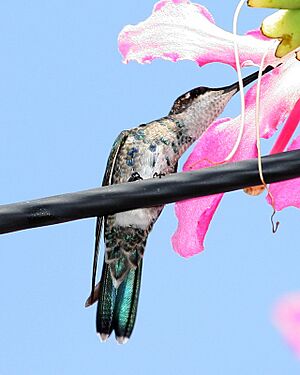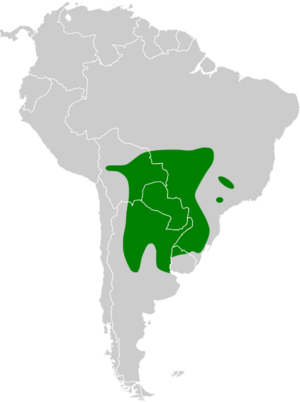Blue-tufted starthroat facts for kids
Quick facts for kids Blue-tufted starthroat |
|
|---|---|
 |
|
| Conservation status | |
| Scientific classification | |
| Genus: |
Heliomaster
|
| Species: |
furcifer
|
 |
|
The blue-tufted starthroat (Heliomaster furcifer) is a type of hummingbird found in South America. It's known for its bright colors and quick movements. These tiny birds live in several countries, including Argentina, Bolivia, Brazil, Colombia, Paraguay, Peru, and Uruguay. They are part of a group of hummingbirds called "mountain gems."
Contents
What is a Blue-tufted Starthroat?
Scientists group living things into categories. This helps us understand them better. The blue-tufted starthroat belongs to a group called Heliomaster. For a while, it was the only bird in this group. But later, scientists found that three other hummingbird species also fit into the Heliomaster group. This bird is considered "monotypic," which means it's the only type within its specific species.
How to Spot a Blue-tufted Starthroat
This hummingbird is about 12.6 to 13 centimeters (5 inches) long. It weighs between 5 and 6.5 grams (about 0.2 ounces). Both male and female birds have a long, curved, black beak. They also have a small white spot right behind each eye.
Male Blue-tufted Starthroats
When breeding, males are very colorful. Their head, neck, and upper back are a shiny emerald green. The rest of their upper body is a sparkling coppery green. Their throat is a bright, glittering violet. The feathers on their belly and sides of their neck are a shimmering blue. Their tail is dark green on top and blue-green underneath. When not breeding, males look more like females, with grayish undersides.
Female Blue-tufted Starthroats
Females have coppery green upper parts. Their throat and belly are gray. A white line runs down the middle of their belly. They also have green spots on their sides. Their tail is bronze green on top. The central tail feathers have black tips. The underside of their tail is shining blue-green. The outer feathers have white tips.
Where Do They Live?
The main areas where blue-tufted starthroats live are eastern Bolivia, southern Brazil, Paraguay, northern Argentina, and northern Uruguay. They have also been seen in Colombia and Peru. There is one report of them in Ecuador, but it has not been officially confirmed.
Their Favorite Places
These birds like open areas. You can find them at the edges of forests. They also live in grasslands and a type of open woodland called cerrado.
How Do They Behave?
Moving Around
Scientists don't know much about how blue-tufted starthroats move. Sometimes, they are seen far from their usual homes. This might mean they travel to new places after the breeding season. They might also spread out to find new food sources.
What Do They Eat?
Blue-tufted starthroats mostly drink nectar from many different kinds of flowers. They are very important pollinators for some plants. For example, they help pollinate a flowering vine called Dolichandra cynanchoides. These birds usually feed between 2 and 8 meters (6.5 to 26 feet) above the ground. Male birds will protect their favorite flower patches from other birds. Besides nectar, they also catch small insects. They often catch insects by flying out from a perch and snatching them in the air. This is called "hawking."
Raising a Family
The breeding season for blue-tufted starthroats is from November to March. The female builds a cup-shaped nest. She uses soft plant fibers and covers the outside with lichen. The nest is usually placed about 3 to 6 meters (10 to 20 feet) high in a tree. The female lays two eggs. She sits on the eggs for 15 to 16 days until they hatch. The young birds leave the nest about 20 to 25 days after hatching.
Their Calls
The blue-tufted starthroat does not seem to have a complex song. However, it does make a special call. It sounds like a pure, descending whistle, often described as "tseep."
Are They in Danger?
The IUCN (International Union for Conservation of Nature) has listed the blue-tufted starthroat as a species of "Least Concern." This means they are not currently considered to be in danger of extinction. However, their total population size is unknown. Scientists believe their numbers might be going down. No immediate threats have been found for these birds. They are considered rare in some parts of their large range, but common in others. They also live in some protected areas, which helps keep them safe.


